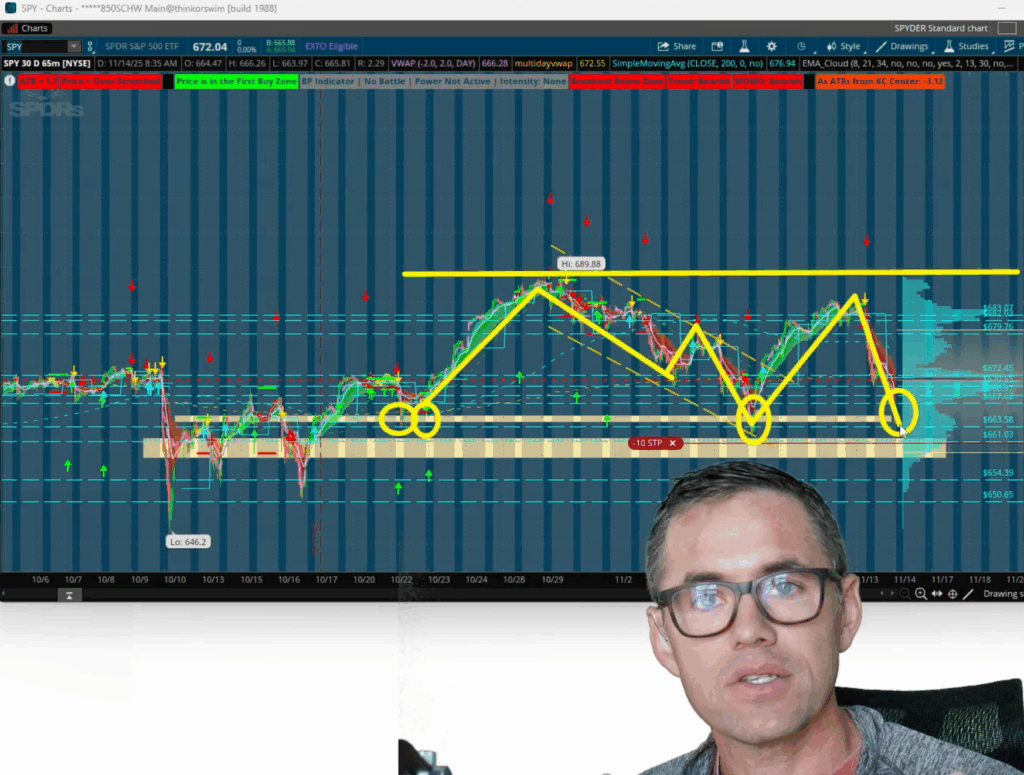Good morning, traders…
I’ve heard a lot of panic over the past few days about the market getting “hammered.”
The S&P 500 dropped 3% in 3 days. Your entire watchlist turned red. And some of your setups might’ve been shaken out.
The concerned questions are swirling. Is this the start of a huge correction? A sell-the-news event? An AI bubble?
Let me be clear: From where I’m sitting, this is not a crash. This is chop.
If you zoom out a bit, the picture is clear…
Since late October, the SPDR S&P 500 ETF Trust (NYSE: SPY) has been bouncing between a top resistance level, the point of control, and support levels.
Several “touches” on the chart show both ends of the range holding:

That’s normal consolidation. The market is digesting gains, not collapsing.
But there’s a reason the chop feels particularly brutal right now…
Something just happened that hasn’t occurred in 104 years. And it’s creating a sense of uncertainty that’s repricing the entire market.
Understanding what changed (and how to adapt) can protect your account while everyone else bleeds.
This Hasn’t Happened In Over 100 Years.
The Data That Isn’t Coming
For the first time since 1921 (104 years ago), monthly economic data won’t be reported at all.
The market hates uncertainty. It loves to fill gaps.
And right now, we have a massive data gap.
No jobs report. No inflation numbers. No consumer spending data.
Nothing.
Why does missing one month of data matter?
The recent market strength has been pricing in interest rate cuts. Traders and investors are expecting the Fed to keep cutting.
But the Fed is data-driven. Chairman Powell repeatedly bases decisions on “if the data shows…”
He doesn’t make moves based on gut feeling. He waits for the numbers.
Without data, the Fed can’t confirm whether the economy is cooling, heating up, or holding steady.
And that uncertainty changes everything…
Rate Cuts Just Became A Coin Flip
Why do rate cuts matter so much?
Lower rates make borrowing cheaper. Cheaper borrowing fuels business expansion, consumer spending, and stock buybacks.
Money flows into risk assets when the Fed cuts rates. It’s mega-bullish for stocks.
But the market doesn’t wait for rate cut announcements. It prices them in ahead of time.
Just days ago, the market priced in an 80%+ chance of a December rate cut.
Now? Around 50%.
From high-probability to a coin flip.
This uncertainty forces repricing downward. When the probability shifts from 85% to 50%, traders reduce risk.
That repricing creates selling pressure. That selling pressure creates chop.
The 3% drop in 3 days was the market adjusting to the new reality, where a December cut went from “almost certain” to a red-or-black roulette bet.
Let The VIX Guide The Way
The VIX measures fear in the market. When it spikes, traders are buying protection against downside moves.
I use the VIX to gauge my risk management. It tells me when conditions favor being long and when I’m fighting a losing battle.
Three VIX levels matter:
- 18.31 (major caution level)
- 19.37 (greater caution level)
- 22 (the “hard to be long” level)
Recently, the VIX climbed above the mid-band. Then above 18.31. Then above 19.37. Now above 22.
When the VIX climbs like this, you cannot be heavily long. You’re fighting the tide.
I wasn’t feeling this way at the beginning of the week. I thought the “reopening trade” would have more follow-through after the government funding agreement passed.
But we have to trade the market we have, not the market we want.
Trying to be heavily long right now is like trying to run into the best defensive line in the NFL. It’s not worth fighting.
The chop will end. Consolidation always does. But forcing trades in a choppy, elevated VIX environment is how accounts blow up.
Build your watchlist. Set your alerts above key resistance levels. Wait for the VIX to come back down and the range to break.
When conditions improve, you’ll be positioned to strike.
Until then, protecting your capital should be top priority.
That’s why I’m going back to the basics and trading the 1 strategy that works in 80% of market conditions.*
I’m talking about the same approach I used to turn $50 into $1,260 in just 2 months…*
And trades such as:
- +159% in 2 days on MRK*
- +49% in 1 day on GOOGL*
- +64% in 2 days on EOSE*
- +244% in 1 day on PYPL*
Now, I’m about to reveal exactly how YOU can weaponize this strategy during my Simpler Options 2-Day Virtual Bootcamp.
If you’ve been wanting to understand how options really work, now is the time…
Grab Your Tickets Before They Run Out.
Happy trading,
Ben Sturgill
*Past performance does not indicate future results

